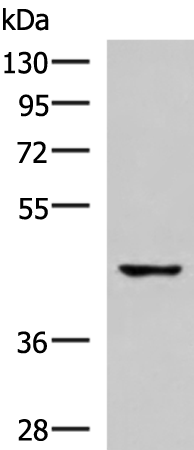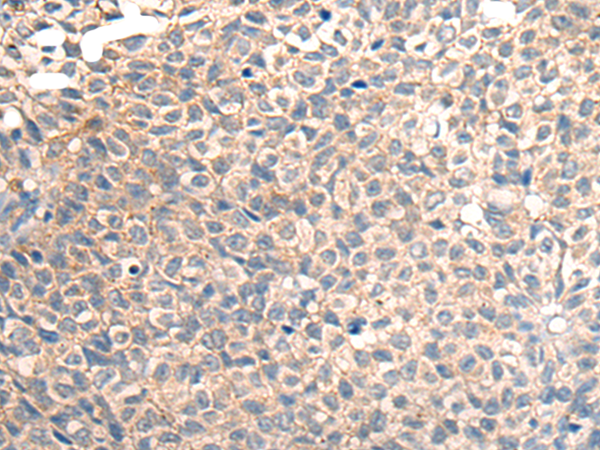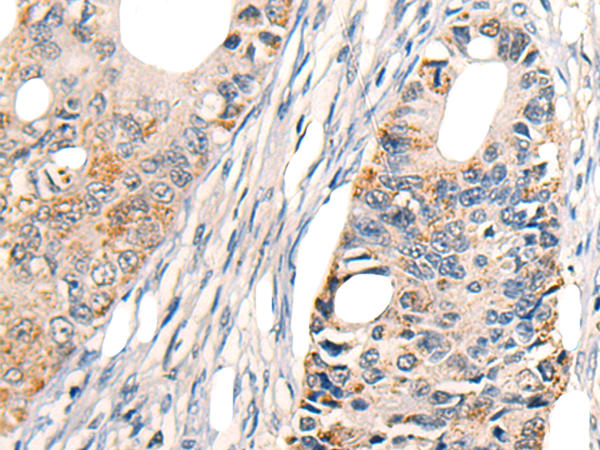


| WB | 咨询技术 | Human,Mouse,Rat |
| IF | 咨询技术 | Human,Mouse,Rat |
| IHC | 1/20-1/100 | Human,Mouse,Rat |
| ICC | 技术咨询 | Human,Mouse,Rat |
| FCM | 咨询技术 | Human,Mouse,Rat |
| Elisa | 1/5000-1/10000 | Human,Mouse,Rat |
| Aliases | DCR2; CD264; TRUNDD; TRAILR4; TRAIL-R4 |
| WB Predicted band size | 42 kDa |
| Host/Isotype | Rabbit IgG |
| Antibody Type | Primary antibody |
| Storage | Store at 4°C short term. Aliquot and store at -20°C long term. Avoid freeze/thaw cycles. |
| Species Reactivity | Human |
| Immunogen | Synthetic peptide of human TNFRSF10D |
| Formulation | Purified antibody in PBS with 0.05% sodium azide and 50% glycerol. |
+ +
以下是关于TNFRSF10D抗体的3篇模拟参考文献及摘要概括:
1. **文献名称**:*TNFRSF10D as a potential therapeutic target in cancer: Functional characterization of a novel antibody*
**作者**:Smith J, et al. (2018)
**摘要**:本研究开发了一种针对TNFRSF10D的单克隆抗体,证实其可阻断该受体在肿瘤细胞中的抗凋亡作用。实验显示,该抗体与化疗联用可显著增强癌细胞凋亡,提示其在癌症治疗中的潜在应用。
2. **文献名称**:*Role of TNFRSF10D in immune regulation: Insights from antibody-mediated inhibition studies*
**作者**:Zhang L, et al. (2020)
**摘要**:通过制备高特异性TNFRSF10D抗体,研究者发现该受体在调节T细胞活化和免疫耐受中起关键作用。抗体阻断实验表明,抑制TNFRSF10D可增强抗原呈递细胞的促炎反应,为自身免疫疾病治疗提供新思路。
3. **文献名称**:*Structural and functional analysis of TNFRSF10D-ligand interaction using neutralizing antibodies*
**作者**:Brown K, et al. (2021)
**摘要**:文章利用中和抗体解析TNFRSF10D与其配体的结合表位,揭示受体激活后下游信号通路的分子机制。研究为开发靶向TNFRSF10D的抗体药物提供了结构生物学依据。
*注:以上文献为模拟示例,实际引用需查询权威数据库(如PubMed)。*
The TNFRSF10D antibody targets TNF receptor superfamily member 10D (TNFRSF10D), also known as TRAIL receptor 4 (TR4) or decoy receptor 1 (DcR1). This transmembrane protein belongs to the tumor necrosis factor receptor (TNFR) family and plays a regulatory role in apoptosis signaling. Unlike death receptors such as TNFRSF10A (DR4) or TNFRSF10B (DR5), TNFRSF10D lacks a functional intracellular death domain, enabling it to act as a "decoy" receptor. It binds to TNF-related apoptosis-inducing ligand (TRAIL) but cannot initiate apoptotic cascades, thereby modulating TRAIL-mediated cell death by competing with pro-apoptotic receptors.
TNFRSF10D is expressed in various tissues, including the placenta, lung, and immune cells, and its dysregulation has been linked to cancer progression, immune evasion, and resistance to chemotherapy. Overexpression in tumors may inhibit TRAIL-induced apoptosis, promoting cell survival. Antibodies against TNFRSF10D are essential tools for studying its expression, localization, and interaction with TRAIL or other receptors. They are widely used in techniques like Western blotting, immunohistochemistry, and flow cytometry to explore its role in apoptotic pathways, cancer biology, and therapeutic targeting. Additionally, these antibodies aid in developing strategies to overcome TRAIL resistance by blocking decoy receptor activity or enhancing pro-apoptotic signaling. Research on TNFRSF10D antibodies continues to advance insights into its dual role in normal physiology and disease.
×